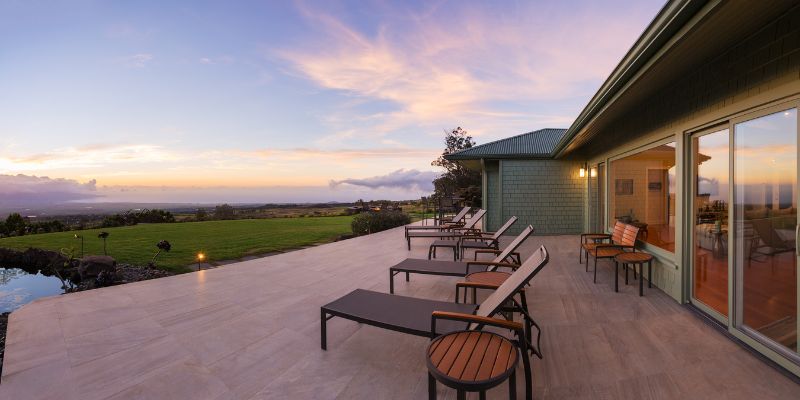Cedar wood is typically reddish-brown in color. It has warm tones and a natural beauty that enhances any space.
Cedar wood is known for its reddish-brown hue, radiating warmth and natural beauty. This distinctive color adds character and charm to any space, making it a popular choice for furniture, flooring, and other interior and exterior applications. The reddish-brown shade of cedar wood not only complements a wide range of aesthetic styles but also brings a sense of rustic elegance to any setting.
Whether used indoors or outdoors, cedar wood’s rich color creates a welcoming and inviting atmosphere. So, whether you’re considering cedar for a cozy cabin interior or a picturesque deck, its warm reddish-brown color will surely enhance the overall ambiance.
The Natural Color Of Cedar Wood
Cedar wood is known for its beautiful natural color, which adds warmth and character to any space. The rich hues and unique patterns make it a popular choice for both interior and exterior applications. Understanding the natural color variations in cedar wood can help you choose the perfect shade for your project. In this article, we will explore the variations in color and the factors that influence the color of cedar wood.
Variations In Color
Cedarwood exhibits a range of colors, from light tan to deep reddish-brown. The exact shade of cedar can vary due to several factors, including the species of cedar, the age of the wood, and environmental conditions.
Here are some common variations in cedar wood color:
- Light Cedar: This lighter shade of cedar wood has a pale tan hue that adds brightness to any space. It is often used in contemporary designs to create an airy and modern feel.
- Medium Cedar: With warm golden-brown tones, medium cedar brings a sense of coziness and natural beauty to any room. It is a popular choice for rustic or traditional decor styles.
- Dark Cedar: The deep reddish-brown color of dark cedar creates a rich and sophisticated ambiance. It adds a touch of elegance to both indoor and outdoor spaces.

Factors Influencing Color
The color of cedar wood is influenced by various factors:
- Cedar Species: Different species of cedar have distinct color characteristics. For example, Western Red Cedar tends to have a reddish or pinkish hue, while Eastern Red Cedar is known for its deeper reddish-brown color.
- Age: As cedar wood ages, its color can darken or develop subtle changes. The exposure to sunlight and natural oxidation processes contribute to these color variations.
- Moisture Content: The moisture content in cedar wood can affect its color. Dry cedar tends to have a deeper and more intense color, while cedar with higher moisture content may appear lighter.
- Finish: The type of finish applied to cedar wood can alter its natural color. Clear finishes or stains can enhance or modify the wood’s hue, providing even more customization options.
By considering the variations in color and the factors influencing it, you can make an informed decision when selecting cedar wood for your next project. Whether you prefer a light, medium, or dark shade, cedar wood’s natural color will bring warmth and charm to any space.
Gorgeous Hues Of Cedar Wood
Cedar wood is renowned for its stunning color variations that add natural beauty to any space. The different species of cedar wood offer unique hues that can range from warm reds and rich yellows to subtle whites. In this blog post, we will explore the mesmerizing colors of three popular types of cedar wood: Red Cedar, White Cedar, and Yellow Cedar.
Red Cedar
One of the most sought-after variations of cedar wood is the Red Cedar, known for its deep and captivating reddish tones. Its vibrant hues are the result of natural pigments and oils present in the wood. Red Cedar boasts a warm and inviting color that enhances the aesthetic appeal of any interior or exterior space. Whether used for furniture, decking, siding, or other applications, the distinctive reddish hue of Red Cedar immediately catches the eye and imparts a sense of elegance and sophistication.
White Cedar
Unlike Red Cedar, White Cedar features a softer and lighter color palette that offers a more subtle charm. Its pale cream or yellowish-white shades bring a timeless beauty to various wood projects. White Cedar’s versatility extends beyond its captivating appearance; this wood type also offers excellent durability and weather resistance. The mellow and neutral hues of White Cedar make it a preferred choice for crafting outdoor furniture, interior paneling, and even rustic architectural features like pergolas, arbors, and fences.
Yellow Cedar
A distinct cedar wood species with a truly exceptional color is Yellow Cedar. As its name suggests, this wood showcases a range of captivating golden-yellow hues. The warm and radiant tones of Yellow Cedar make it an ideal choice for both indoor and outdoor applications. It is widely used in construction projects, furniture making, boat building, and even artistic carvings. The natural color variations of Yellow Cedar add depth and character to any space, creating a cozy and welcoming atmosphere.
Enhancing And Preserving Cedar Wood Color
Cedar wood is prized for its beautiful natural color, which ranges from light brown to a rich red hue. Enhancing and preserving the color of cedar wood helps to maintain its aesthetic appeal and durability. In this article, we will explore effective methods for enhancing and preserving the color of cedar wood, ensuring it remains an attractive and long-lasting material for various applications.
Treatment And Finishes
Applying consistent treatments and finishes to cedar wood can play a significant role in preserving and enhancing its natural color. One popular method is to utilize clear sealants that protect the wood from moisture and UV rays, thus preventing color fading and weathering. Additionally, semi-transparent or transparent stains can be applied to accentuate the natural color while providing an extra layer of protection.
Maintenance Tips
Regular maintenance is essential for keeping cedar wood looking vibrant and pristine. Simple practices, such as regular cleaning to remove dirt and debris, can prevent discoloration and ensure that the wood retains its natural beauty. Fresh applications of sealants and stains as needed are also vital for prolonging the wood’s color and overall integrity.

Credit: www.homedepot.com
Applications Of Cedar Wood In Interior Design
Are you looking to add a touch of warmth and elegance to your interior design? Look no further than the applications of cedar wood. Cedarwood, with its distinct reddish-brown color, is a popular choice in interior design due to its versatile nature and stunning aesthetics. In this article, we will explore two common applications of cedar wood in interior design: furniture and paneling, as well as ceiling and flooring.
Furniture And Paneling
One of the most popular uses of cedar wood in interior design is for furniture and paneling. Cedar wood’s natural reddish-brown color brings a sense of sophistication and warmth to any space. The unique grain patterns of cedar wood make each piece of furniture or paneling one-of-a-kind, adding visual interest to your home or office.
- Choose cedar wood furniture for your living room, bedroom, or dining area to create a cozy and inviting ambiance.
- Panel your walls with cedar wood for a rustic and natural look that enhances the overall aesthetics of your space.
- Cedar wood furniture and paneling can be combined with other materials such as glass or metal to create a modern and eclectic style.
Ceiling And Flooring
If you’re looking to elevate the look and feel of your interior, consider using cedar wood for your ceiling and flooring. Cedar wood ceiling adds a sense of height and spaciousness to a room, creating an open and airy atmosphere. The warm tones and natural beauty of cedar wood flooring add character and charm to any space.
- Install cedar wood ceiling planks to give your room a cozy and rustic look, reminiscent of a log cabin.
- Cedar wood flooring can be stained in various shades to match your overall interior design theme.
- The durability and natural resistance of cedar wood make it an excellent choice for high-traffic areas, ensuring your flooring remains beautiful for years to come.
In conclusion, cedar wood’s rich reddish-brown color and unique grain patterns make it a sought-after material in interior design. Whether used for furniture, paneling, ceilings, or flooring, cedar wood adds warmth, elegance, and a touch of nature to any space. Consider incorporating cedar wood into your interior design to create a truly stunning and inviting environment.
Exterior Uses Of Cedar Wood
When it comes to choosing wood for exterior applications, cedar wood is often the top choice for homeowners and builders. With its natural beauty, durability, and resistance to rot and decay, cedar wood brings a touch of elegance and longevity to outdoor spaces. In this section, we will explore two popular exterior uses of cedar wood: decking and fencing, and siding and trim.
Decking And Fencing
Cedar wood is commonly used for both decking and fencing projects, thanks to its remarkable qualities. As a decking material, cedar wood creates a warm and inviting ambiance, perfect for enhancing outdoor living areas. Its unique color variations range from pale yellow to reddish-brown, giving decks a natural organic feel.
When it comes to fencing, cedar wood stands out for its durability and resistance to weather elements. The natural oils present in cedar wood help protect it from decay and insect damage, ensuring a longer lifespan for your fence. Additionally, cedar’s beautiful colors add an aesthetically pleasing touch to any outdoor space.
Siding And Trim
Another popular use of cedar wood is for siding and trim on buildings and homes. Cedar siding provides an attractive and timeless look, enhancing the overall curb appeal of a property. Its color variations and unique grain patterns add character and beauty to any structure.
The natural resistance of cedar wood to pests, rot, and decay makes it an excellent choice for siding and trim. This means less maintenance and upkeep for homeowners, saving both time and money in the long run.
When using cedar wood for siding and trim, it is essential to properly seal and maintain it to ensure its longevity and beauty. Regular staining or painting, along with periodic cleaning, will help preserve the wood’s natural beauty and protect it from the elements.
Frequently Asked Questions For What Color Is Cedar Wood
Is All Cedar Wood Red?
Not all cedar wood is red; there are different types, such as red cedar and white cedar.
What Colors Look Good With Cedar Wood?
Cedarwood looks good with earthy or neutral colors like beige and brown. These colors create a natural and harmonious look with the warm tones of cedar. Additionally, shades of green and blue can also complement cedar wood, bringing a refreshing and calming feel to the space.
Is Cedar A Light Or Dark?
Cedar can come in both light and dark shades.
What Color Stain Matches Cedar?
Cedar is best matched with light to medium stains like honey or cedar tones. These colors enhance cedar’s natural beauty.
Conclusion
The color of cedar wood can vary from reddish-brown to light yellow. Understanding the natural hues of cedar wood is essential for matching it with other elements in your space. Whether you’re choosing cedar for outdoor furniture or interior accents, being mindful of its color characteristics will ensure a harmonious and visually appealing result.



One thought on “What Color is Cedar Wood? Discover the Enchanting Shades of Cedar.”